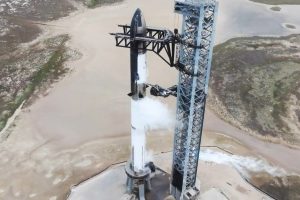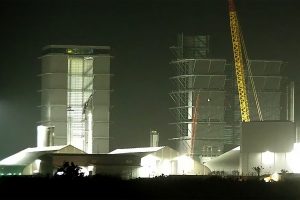- 🚀 SpaceX is preparing for the fifth Starship test flight, Integrated Flight Test 5 (IFT-5).
- ✅ The Federal Communications Commission (FCC) has approved the test flight.
- 📜 Approval from the Federal Aviation Administration (FAA) is still pending and crucial.
- 🛠️ Previous test flights showed steady improvements, with IFT-3 being the first successful one.
- ⏳ CEO Elon Musk expected the flight in early August, but it has been delayed.
As SpaceX inches closer to its fifth Starship test flight, Integrated Flight Test 5 (IFT-5), the aerospace community watches with bated breath. This pivotal moment in space exploration is a testament to SpaceX’s relentless pursuit of innovation. This blog post delves into the current status of IFT-5, the challenges it faces, and what it means for the future of space travel.
The Road to Integrated Flight Test 5 (IFT-5)
SpaceX’s Starship program is integral to the company’s vision of making space travel more affordable and accessible. The upcoming IFT-5 is set to build on the achievements and lessons learned from the previous four test flights. Here’s a look at the journey so far:
- IFT-1 and IFT-2: While these initial attempts were labeled as “failures,” they were rich learning experiences that laid the groundwork for future improvements.
- IFT-3: Marked a significant milestone with a successful demonstration of key flight capabilities, silencing many critics and bolstering SpaceX’s confidence.
- IFT-4: Showcased further enhancements in performance, setting the stage for the upcoming IFT-5.
Navigating Approval Hurdles
In the world of aerospace, regulatory approvals are as critical as technological milestones. Currently, SpaceX has successfully secured approval from the Federal Communications Commission (FCC), a significant step forward. However, the more stringent and vital approval from the Federal Aviation Administration (FAA) remains outstanding.
Requirements for FAA Approval
To gain FAA approval, SpaceX must satisfy a comprehensive list of requirements focusing on safety and environmental impact. Key components include:
- Safety Protocols: Ensuring that the flight does not pose any risk to public safety.
- Environmental Considerations: Assessing the ecological footprint of the launch.
- Technical Readiness: Demonstrating that all systems can perform as intended.
The Impact of FCC and FAA Approvals
Approval from these agencies is not a mere formality; it is instrumental in shaping the trajectory of SpaceX’s launch capabilities. The influence of these approvals can be seen in:
- Launch Scheduling: Regulatory delays can impact projected timelines, as seen with the current delay from Musk’s early August projection.
- Public and Investor Confidence: Securing approvals lends credibility and aligns SpaceX with global safety standards.
Future Implications and the Road Ahead
The completion and success of IFT-5 could solidify SpaceX’s place at the forefront of space exploration. Looking ahead, SpaceX aspires to leverage its Starship for ambitious missions, including lunar landings and, eventually, crewed missions to Mars.
Conclusion
SpaceX’s journey toward IFT-5 is not just a story of technological progress but also a narrative of navigating complex regulatory landscapes. Each milestone achieved brings humanity closer to the stars, promising a thrilling future of interplanetary exploration. As we await FAA’s decision, the anticipation grows for what could be a groundbreaking event in aerospace history.





